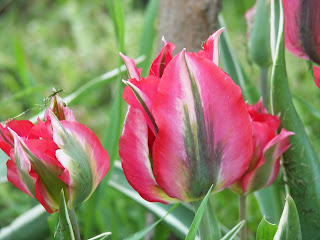There are many animals and birds that stay active throughout the winter in our area.
There are times when I look out my windows in the dead of winter and wonder how anything can find adequate shelter, food and water.
There are many decorative perennials, bushes and trees that can add sustenance to their diet and shelter. When shopping for additions to your landscape, consider some of the following:
Squirrels: Primarily vegetarians, living on seeds, nuts, fruits, fungi, lichens, buds, mushrooms, roots, pine cones, leaves, twigs, bark and other things as they may find laying around. They live in cavities in large trees during cold winter months to keep them warm. One use for their tail is to keep them warm in winter. (Beware: Starlings' favorite winter food is cracked corn.)
Cardinals: Aphids, beetles, cutworms, corn, oats, and weed seeds (Feeders for sunflower seeds.)
Red Bellied Woodpecker: Weed seeds, insects, berries (Feeders for seeds & suet.)
Downy Woodpecker: Aphids, insect eggs, spiders, acorns, sap, and berries. (Feeders for suet, cornbread, and peanut butter.)
Sparrows: beetles, flies, ants, weed seeds, grain, and fruit. (Feeders for seeds and bread.)
Blue Jays: Beetles, spiders, insects, acorns, blueberries, and currants. (Feeders for seeds, suet and peanuts.)
Finches: Mostly seeds, but they also eat fruit, beetles, birch and maple buds. (Feeders for seeds.)
Doves: Weed seeds on the ground (will clean seeds from under feeders.)
Black-capped Chickadee: Caterpillars, insects eggs, beetles, ants, aphids, fruit and seeds. (Feeders for suet, sunflower seeds, and peanut butter.)
Having your feeders in place and filled in September, will allow birds to find and get used to the location. You must keep food in the feeders all the time if you want them to remember. Squirrels will remember.
When selecting a feeder - here are some general guides:
Suet feeders attract: woodpeckers, chickadees, wrens, nuthatches, cardinals, doves, goldfinches
Peanut butter suet attracts: woodpeckers, juncos, goldfinches, jays, cardinals, bluebirds
House feeders w/ sunflower seeds: cardinals. finches, grosbeaks, sparrows, chickadees
Peanut feeders attract: woodpeckers, and chickadees
Tube feeder w/thistle (niger seed) or black sunflower seed: woodpeckers, finches, sparrows
Tray feeder with fruit will attract: woodpeckers, starlings, bluebirds, cardinals, jays
Platform feeders with sunflower seed attract: cardinals, doves, woodpeckers, finches, chickadees, sparrows, goldfinches, grosbeaks, jays
Feeders and the food that drops on the ground are also used by squirrels, raccoons, opossums, rats, and those interested in a bird for dinner - cats and hawks.
You may choose to provide fresh water all winter. This will require a heated source and there are several varieties available.
_____________________
Feeding deer, foxes, and other wild animals near your home is risky business unless you have thought it out and know the ramifications. Feeding wild animals in the winter will train them to feed on your summer flowers, trees, bushes, dog & cat food, and garbage. Horror stories abound.
_____________________
While enjoying these beautiful autumn days, it's hard to believe winter will soon be here. Never fear, our seasons are reliable. A few feeders in your yard and you'll be able to enjoy the antics of our winter animals and birds all winter. In addition, you will provide them with some added comforts.
.JPG)








.JPG)

.JPG)










.JPG)
.JPG)


.JPG)



.JPG)

